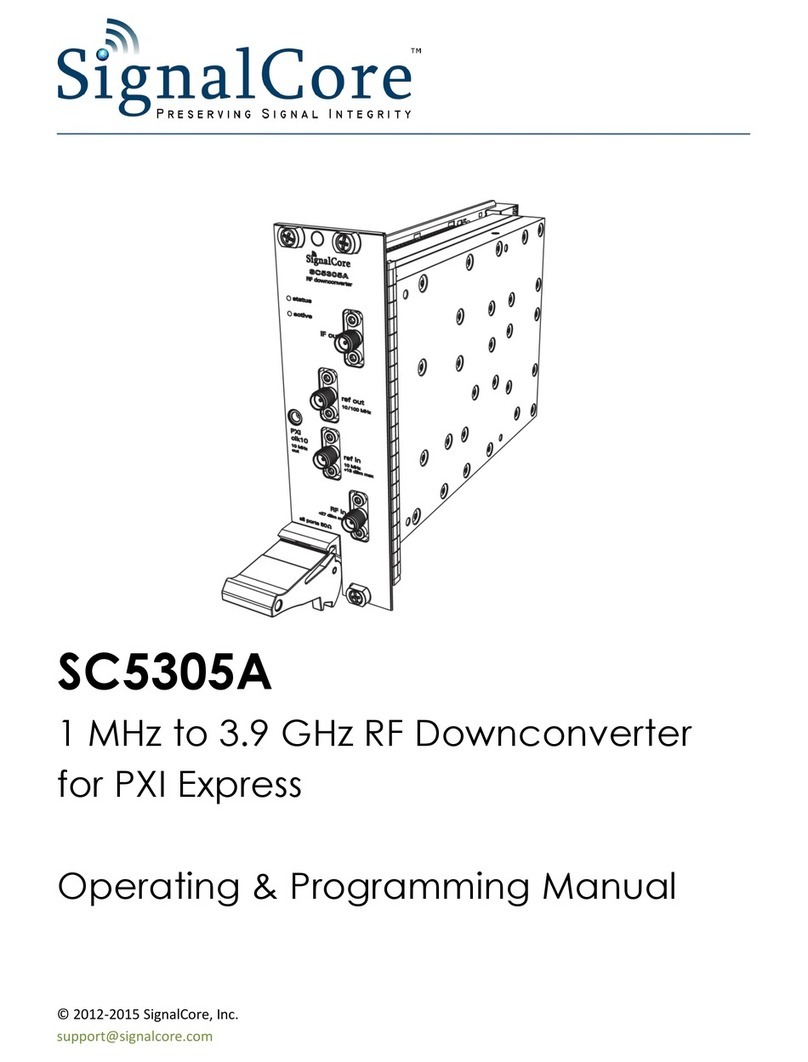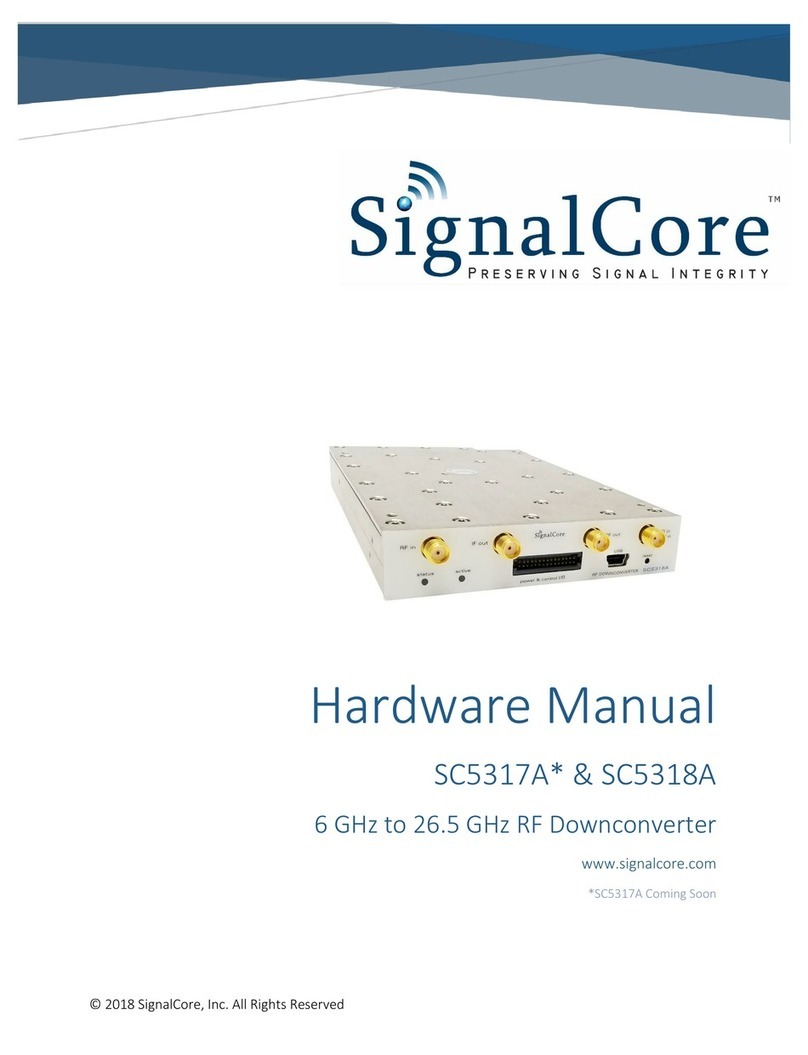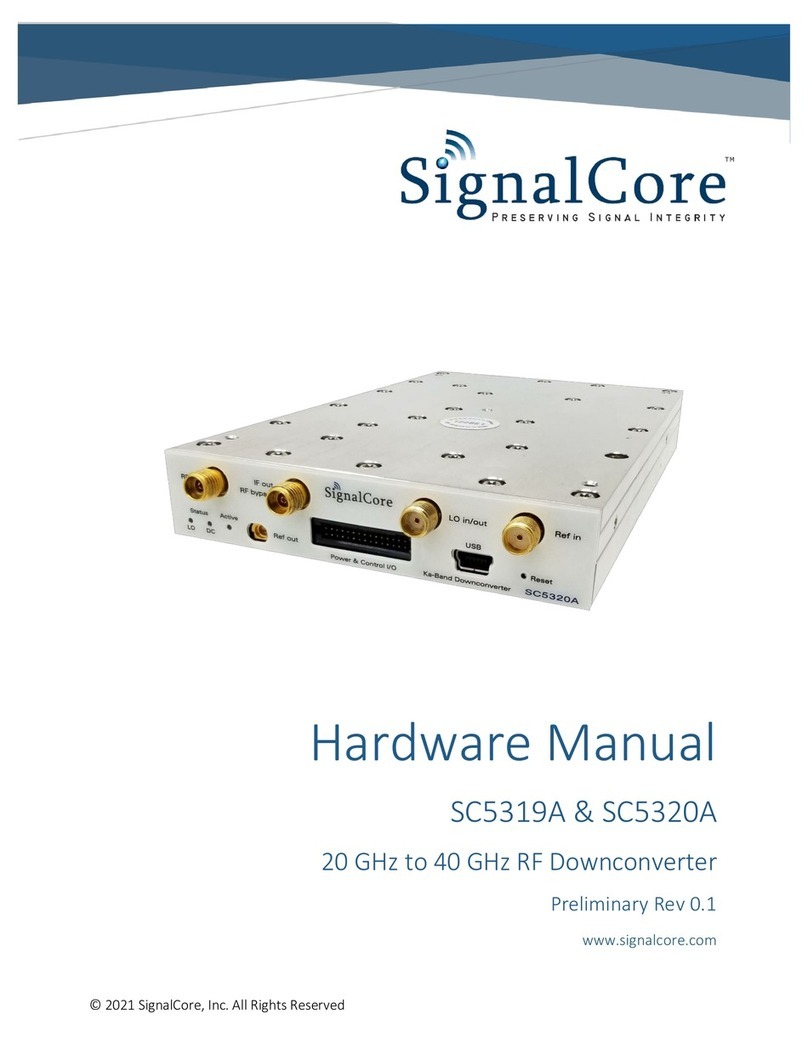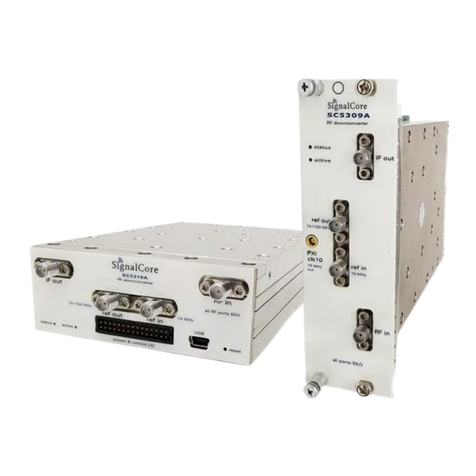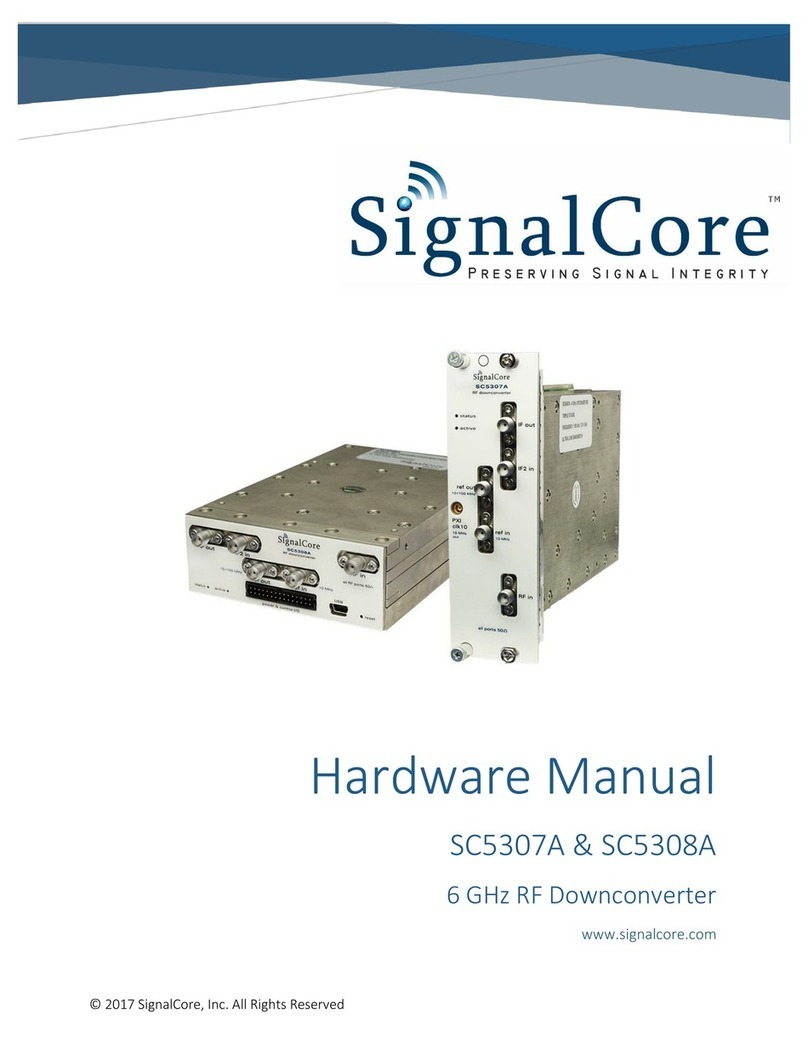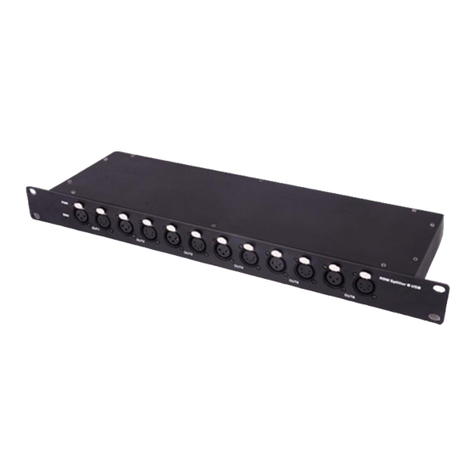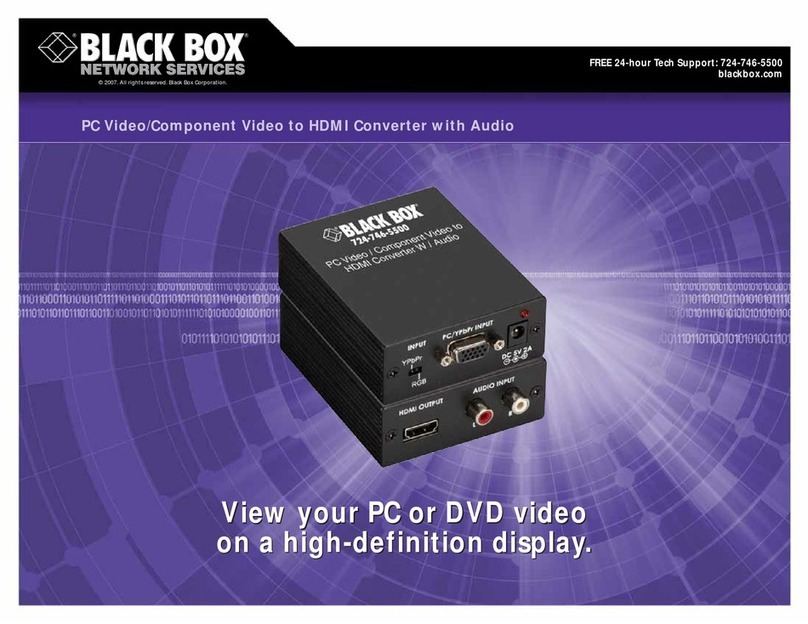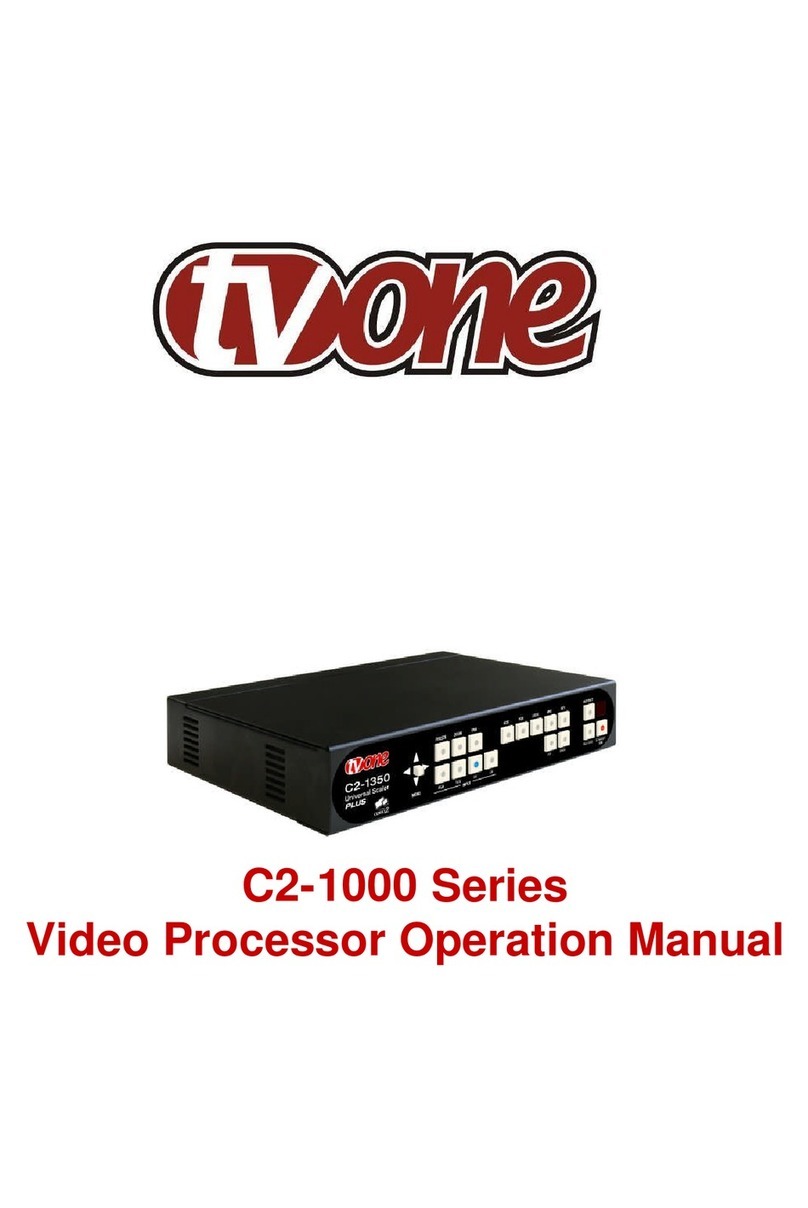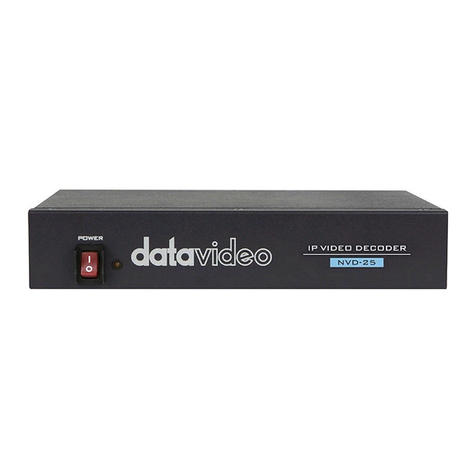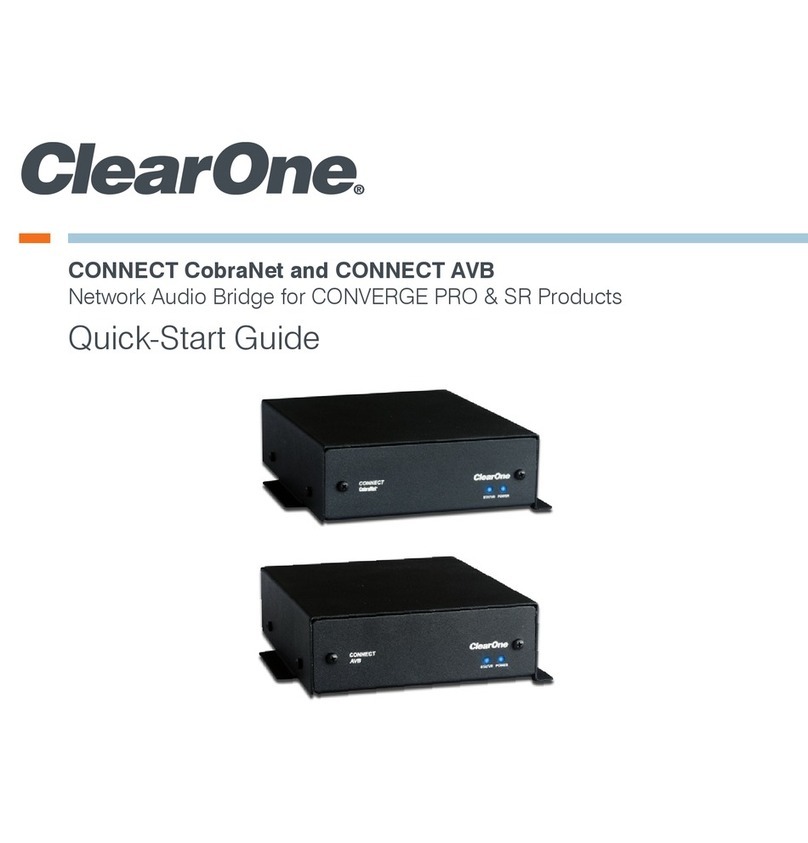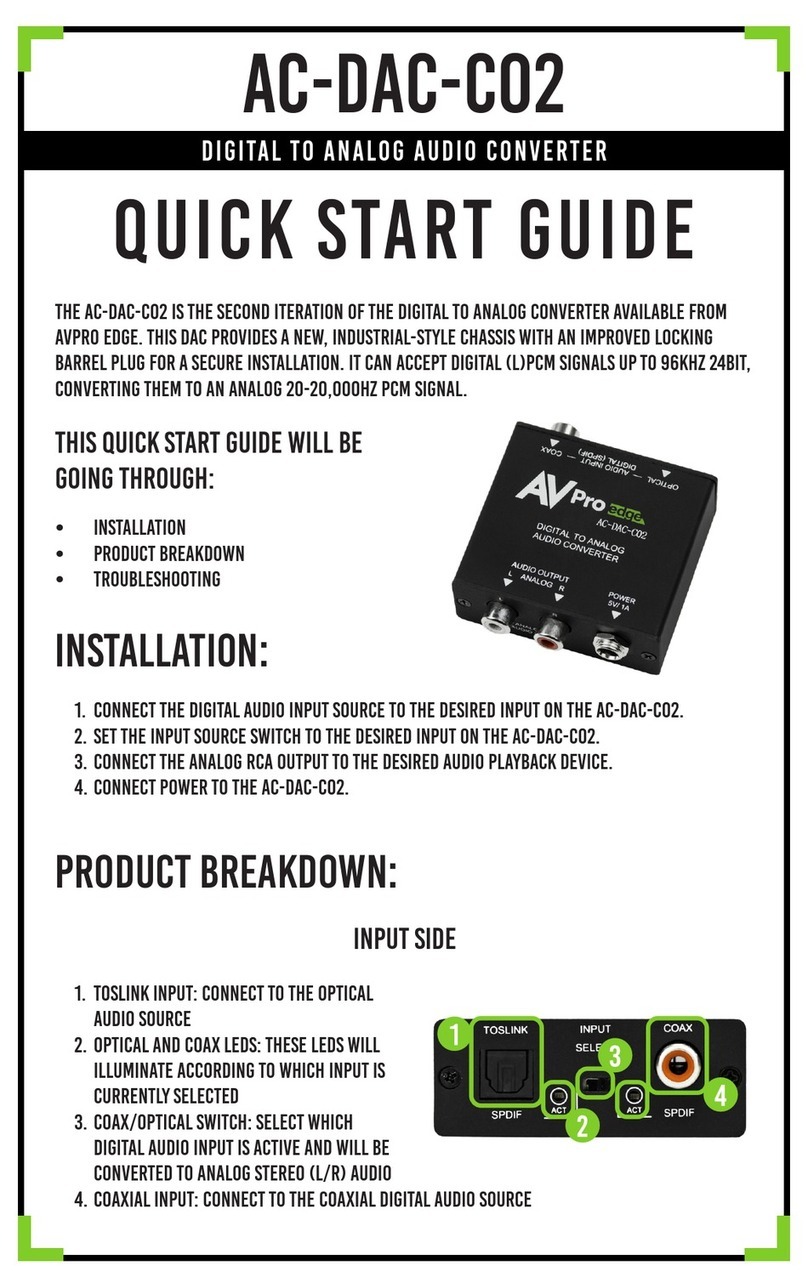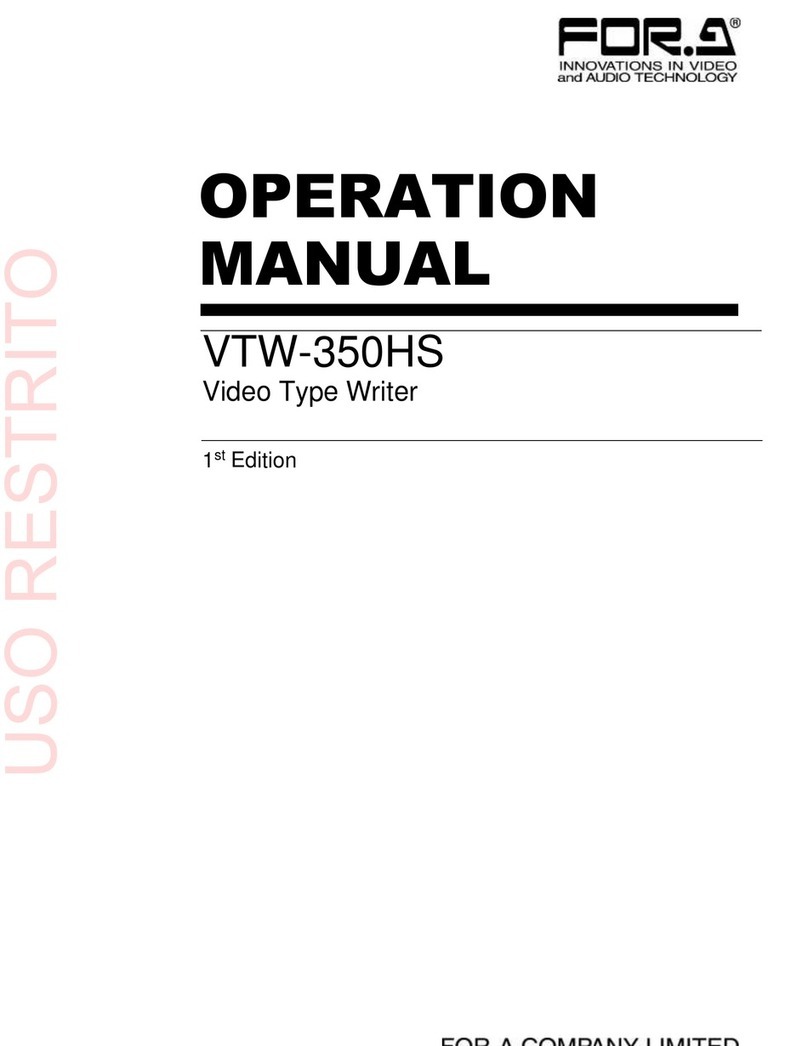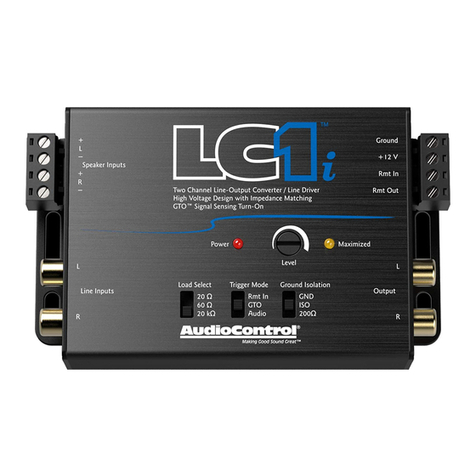SIGNALCORE SC5407A User manual

©2021 Rev 2.2
1
General Information
Table of Contents
1 General Information ...............................................................................................................................4
Warranty .......................................................................................................................................4
Copyright & Trademarks................................................................................................................4
International Materials Declarations.............................................................................................5
CE European Union EMC & Safety Compliance Declaration..........................................................5
Warnings Regarding Use of SignalCore Products ..........................................................................6
2 Physical Description................................................................................................................................7
Unpacking......................................................................................................................................7
Setting Up the Device....................................................................................................................7
Front Interface Indicators and Connectors....................................................................................8
Signal Connections ................................................................................................................9
Device LED Indicators ..........................................................................................................10
Communication and Supply Connection .............................................................................10
Mini-USB Connection ..........................................................................................................11
Reset Button (Pin Hole) .......................................................................................................12
3 Functional Description..........................................................................................................................13
Overview .....................................................................................................................................13
The Signal Chain ..........................................................................................................................14
The RF Input ........................................................................................................................14
The IF3 Input Path and IF3 Mixer ........................................................................................15
The IF2 Path and Second Mixer...........................................................................................15
External IF2 Input ................................................................................................................16
The First Mixer and IF1 Path................................................................................................16
The RF Path..........................................................................................................................16
The RF Output Path Switch..................................................................................................17
Signal Chain Configurations.................................................................................................17
The LO Module............................................................................................................................18
The Reference Clocks ..........................................................................................................18
The First Local Oscillator (LO1)............................................................................................19
The Second Local Oscillator (LO2) .......................................................................................19
The Third Local Oscillator (LO3)...........................................................................................19
The Interface Module..................................................................................................................20

Rev 2.2 | SC5407A & SC5408A Hardware Manual SignalCore, Inc.
2
SC5407A & SC5408A Hardware Manual
4 Hardware Registers...............................................................................................................................21
Configuration Registers ...............................................................................................................21
Register 0x01 INITIALIZE......................................................................................................22
Register 0x02 SYSTEM_ACTIVE............................................................................................23
Register 0x03 SYNTH_MODE (2 Bytes) ................................................................................23
Register 0x10 RF_FREQUENCY ............................................................................................23
Register 0x11 IF_FREQUENCY..............................................................................................24
Register 0x14 RF_FILTER......................................................................................................24
Register 0x15 ATTENUATOR................................................................................................25
Register 0x16 SIGNAL_PATH................................................................................................25
Register 0x17 CONFIG_AUTO_GAIN....................................................................................26
Register 0x18 STORE_DEFAULT_STATE ...............................................................................27
Register 0x19 DEVICE_STANDBY .........................................................................................28
Register 0x1A REFERENCE_CLOCK.......................................................................................28
Register 0x1B REFERENCE_DAC...........................................................................................29
Register 0x1C LO1_PATH.....................................................................................................29
Register 0x1D SYNTH_SELF_CAL..........................................................................................30
Register 0x1E USER_EEPROM_WRITE .................................................................................30
Register 0x1F FREQ_PLAN_PARAM .....................................................................................30
Query Registers ...........................................................................................................................31
Register 0x30 GET_DEVICE_PARAM....................................................................................32
Register 0x31 GET_TEMPERATURE .....................................................................................32
Register 0x32 GET_DEVICE_STATUS....................................................................................33
Register 0x33 GET_DEVICE_INFO........................................................................................34
Register 0x35 CAL_EEPROM_READ .....................................................................................35
Register 0x36 USER_EEPROM_READ...................................................................................35
Register 0x37 SERIAL_OUT_BUFFER....................................................................................36
Device Parameters Data and Format...................................................................................36
Device Information Parameters and Format.......................................................................37
5 Communication Interfaces......................................................................................................................1
Communication Data Format ........................................................................................................1
USB Interface................................................................................................................................. 1
Control Transfer ....................................................................................................................1

©2021 Rev 2.2
3
General Information
Bulk Transfer .........................................................................................................................1
SPI Interface ..................................................................................................................................2
Writing the SPI Bus................................................................................................................3
Reading the SPI Bus ...............................................................................................................3
RS232 Interface .............................................................................................................................4
Writing to the Device Via RS232............................................................................................4
Reading from the Device Via RS232 ......................................................................................5
PXI Express ....................................................................................................................................5
Setting Up the PCI to Serial Bridge ........................................................................................5
Writing to the Device.............................................................................................................6
Reading from the Device .......................................................................................................6
6 Calibration ..............................................................................................................................................7
Calibration EEPROM Map..............................................................................................................7
Absolute Conversion Gain .............................................................................................................8
Absolute Gain of the RF Conversion Path......................................................................................8
Gain Through the Bypass RF Conversion Path...............................................................................9
Applying Calibration ..............................................................................................................9
Revision Table..............................................................................................................................................11

Rev 2.2 | SC5407A & SC5408A Hardware Manual SignalCore, Inc.
4
SC5407A & SC5408A Hardware Manual
1General Information
Warranty
This product is warranted against defects in materials and workmanship for a period of three years
from the date of shipment. SignalCore will, at its option, repair or replace equipment that proves to
be defective during the warranty period. This warranty includes parts and labor.
Before any equipment will be accepted for warranty repair or replacement, a Return Material
Authorization (RMA) number must be obtained from a SignalCore customer service representative
and clearly marked on the outside of the return package. SignalCore will pay all shipping costs
relating to warranty repair or replacement.
SignalCore strives to make the information in this document as accurate as possible. The document
has been carefully reviewed for technical and typographic accuracy. If technical or typographical
errors exist, SignalCore reserves the right to make changes to subsequent editions of this document
without prior notice to possessors of this edition. Please contact SignalCore if errors are suspected.
In no event shall SignalCore be liable for any damages arising out of or related to this document or
the information contained in it.
EXCEPT AS SPECIFIED HEREIN, SIGNALCORE, INCORPORATED MAKES NO WARRANTIES, EXPRESS OR
IMPLIED, AND SPECIFICALLY DISCLAIMS ANY WARRANTY OF MERCHANTABILITY OR FITNESS FOR A
PARTICULAR PURPOSE. CUSTOMER’S RIGHT TO RECOVER DAMAGES CAUSED BY FAULT OR
NEGLIGENCE ON THE PART OF SIGNALCORE, INCORPORATED SHALL BE LIMITED TO THE AMOUNT
THERETOFORE PAID BY THE CUSTOMER. SIGNALCORE, INCORPORATED WILL NOT BE LIABLE FOR
DAMAGES RESULTING FROM LOSS OF DATA, PROFITS, USE OF PRODUCTS, OR INCIDENTAL OR
CONSEQUENTIAL DAMAGES, EVEN IF ADVISED OF THE POSSIBILITY THEREOF. This limitation of the
liability of SignalCore, Incorporated will apply regardless of the form of action, whether in contract
or tort, including negligence. Any action against SignalCore, Incorporated must be brought within
one year after the cause of action accrues. SignalCore, Incorporated shall not be liable for any delay
in performance due to causes beyond its reasonable control. The warranty provided herein does not
cover damages, defects, malfunctions, or service failures caused by owner’s failure to follow
SignalCore, Incorporated’s installation, operation, or maintenance instructions; owner’s
modification of the product; owner’s abuse, misuse, or negligent acts; and power failure or surges,
fire, flood, accident, actions of third parties, or other events outside reasonable control.
Copyright & Trademarks
Under the copyright laws, this publication may not be reproduced or transmitted in any form,
electronic or mechanical, including photocopying, recording, storing in an information retrieval
system, or translating, in whole or in part, without the prior written consent of SignalCore,
Incorporated.
SignalCore, Incorporated respects the intellectual property rights of others, and we ask those who
use our products to do the same. Copyright and other intellectual property laws protect our

©2021 Rev 2.2
5
General Information
products. Use of SignalCore products is restricted to applications that do not infringe on the
intellectual property rights of others.
“SignalCore”, “signalcore.com”, and the phrase “preserving signal integrity” are registered
trademarks of SignalCore, Incorporated. Other product and company names mentioned herein are
trademarks or trade names of their respective companies.
International Materials Declarations
SignalCore, Incorporated uses a fully RoHS compliant manufacturing process for our products.
Therefore, SignalCore hereby declares that its products do not contain restricted materials as
defined by European Union directive 2002/95/EC (EU RoHS) in any amounts higher than limits stated
in the directive. This statement assumes reliable information and data provided by our component
suppliers and may not have been independently verified through other means. For products sold
into China, we also comply with the “Administrative Measure on the Control of Pollution Caused by
Electronic Information Products” (China RoHS). In the current stage of this legislation, the content of
six hazardous materials must be explicitly declared. Each of those materials, and the categorical
amount present in our products, are shown below:
鉛
Lead
(Pb)
汞
Mercury
(Hg)
镉
Cadmium
(Cd)
六价铬
Hexavalent
Chromium
(Cr(VI))
多溴联苯
Polybrominated
biphenyls
(PBB)
多溴二苯醚
Polybrominated
diphenyl ethers
(PBDE)
✓
✓
✓
✓
✓
✓
A ✓indicates that the hazardous substance contained in all of the homogeneous materials for this
product is below the limit requirement in SJ/T11363-2006. An Xindicates that the particular
hazardous substance contained in at least one of the homogeneous materials used for this product
is above the limit requirement in SJ/T11363-2006.
CE European Union EMC & Safety Compliance Declaration
The European Conformity (CE) marking is affixed to products with input of 50 - 1,000 Vac or 75 -
1,500 Vdc and/or for products which may cause or be affected by electromagnetic disturbance. The
CE marking symbolizes conformity of the product with the applicable requirements. CE compliance
is a manufacturer’s self-declaration allowing products to circulate freely within the European Union
(EU). SignalCore products meet the essential requirements of Directives 2004/108/EC (EMC) and
2006/95/EC (product safety) and comply with the relevant standards. Standards for Measurement,
Control and Laboratory Equipment include EN 61326 and EN 55011 for EMC, and EN 61010-1 for
product safety.

Rev 2.2 | SC5407A & SC5408A Hardware Manual SignalCore, Inc.
6
SC5407A & SC5408A Hardware Manual
Warnings Regarding Use of SignalCore Products
(1)
PRODUCTS FOR SALE BY SIGNALCORE, INCORPORATED ARE NOT DESIGNED WITH COMPONENTS NOR TESTED
FOR A LEVEL OF RELIABILITY SUITABLE FOR USE IN OR IN CONNECTION WITH SURGICAL IMPLANTS OR AS
CRITICAL COMPONENTS IN ANY LIFE SUPPORT SYSTEMS WHOSE FAILURE TO PERFORM CAN REASONABLY BE
EXPECTED TO CAUSE SIGNIFICANT INJURY TO A HUMAN.
(2)
IN ANY APPLICATION, INCLUDING THE ABOVE, RELIABILITY OF OPERATION OF THE SOFTWARE PRODUCTS CAN
BE IMPAIRED BY ADVERSE FACTORS, INCLUDING BUT NOT LIMITED TO FLUCTUATIONS IN ELECTRICAL POWER
SUPPLY, COMPUTER HARDWARE MALFUNCTIONS, COMPUTER OPERATING SYSTEM SOFTWARE FITNESS,
FITNESS OF COMPILERS AND DEVELOPMENT SOFTWARE USED TO DEVELOP AN APPLICATION, INSTALLATION
ERRORS, SOFTWARE AND HARDWARE COMPATIBILITY PROBLEMS, MALFUNCTIONS OR FAILURES OF
ELECTRONIC MONITORING OR CONTROL DEVICES, TRANSIENT FAILURES OF ELECTRONIC SYSTEMS
(HARDWARE AND/OR SOFTWARE), UNANTICIPATED USES OR MISUSES, OR ERRORS ON THE PART OF THE USER
OR APPLICATIONS DESIGNER (ADVERSE FACTORS SUCH AS THESE ARE HEREAFTER COLLECTIVELY TERMED
“SYSTEM FAILURES”). ANY APPLICATION WHERE A SYSTEM FAILURE WOULD CREATE A RISK OF HARM TO
PROPERTY OR PERSONS (INCLUDING THE RISK OF BODILY INJURY AND DEATH) SHOULD NOT BE SOLELY
RELIANT UPON ANY ONE COMPONENT DUE TO THE RISK OF SYSTEM FAILURE. TO AVOID DAMAGE, INJURY,
OR DEATH, THE USER OR APPLICATION DESIGNER MUST TAKE REASONABLY PRUDENT STEPS TO PROTECT
AGAINST SYSTEM FAILURES, INCLUDING BUT NOT LIMITED TO BACK-UP OR SHUT DOWN MECHANISMS.
BECAUSE EACH END-USER SYSTEM IS CUSTOMIZED AND DIFFERS FROM SIGNALCORE'S TESTING PLATFORMS,
AND BECAUSE A USER OR APPLICATION DESIGNER MAY USE SIGNALCORE PRODUCTS IN COMBINATION WITH
OTHER PRODUCTS IN A MANNER NOT EVALUATED OR CONTEMPLATED BY SIGNALCORE, THE USER OR
APPLICATION DESIGNER IS ULTIMATELY RESPONSIBLE FOR VERIFYING AND VALIDATING THE SUITABILITY OF
SIGNALCORE PRODUCTS WHENEVER SIGNALCORE PRODUCTS ARE INCORPORATED IN A SYSTEM OR
APPLICATION, INCLUDING, WITHOUT LIMITATION, THE APPROPRIATE DESIGN, PROCESS AND SAFETY LEVEL
OF SUCH SYSTEM OR APPLICATION.

©2021 Rev 2.2
7
Physical Description
2Physical Description
Unpacking
All SignalCore products ship in antistatic packaging (bags) to prevent damage from electrostatic
discharge (ESD). Under certain conditions, an ESD event can instantly and permanently damage
several of the components found in SignalCore products. Therefore, to avoid damage when handling
any SignalCore hardware, you must take the following precautions:
1. Ground yourself using a grounding strap or by touching a grounded metal object.
2. Touch the antistatic bag to a grounded metal object before removing the hardware from
its packaging.
3. NEVER touch exposed signal pins. Due to the inherent performance degradation caused
by ESD protection circuits in the RF path, the device has minimal ESD protection against
direct injection of ESD into the RF signal pins.
4. When not in use, store all SignalCore products in their original antistatic bags.
Remove the product from its packaging and inspect it for loose components or any signs of damage.
Notify SignalCore immediately if the product appears damaged in any way.
Setting Up the Device
Integration of the SC5407A and SC5408A modules requires attention to maintain effective cooling.
Inadequate cooling can cause the temperature inside the RF housing to rise above the maximum for
this product, leading to improper performance, reduction of product lifespan, or complete product
failure. SignalCore suggests providing moderate airflow across the RF housing. If active cooling is not
an option, use thermal interface materials to bond the RF housing to a larger heatsinking surface (i.e.
a system enclosure). As each device’s integrated system configuration is unique, detailed cooling
options cannot be provided.
A cooling plan is sufficient when the SC5407A and SC5408A on-board temperature sensors indicate a
rise of no more than 20°C above ambient temperature under normal operating conditions.

Rev 2.2 | SC5407A & SC5408A Hardware Manual SignalCore, Inc.
8
SC5407A & SC5408A Hardware Manual
Front Interface Indicators and Connectors
The SC5407A is a PXIe-based RF upconverter with all user I/O located on the front face of the module.

©2021 Rev 2.2
9
Physical Description
The SC5408A is a serial controlled core module with all user connections on the front face of the
module.
Signal Connections
All signal connections (ports) on the device are female SMA-type. Exercise caution when fastening
cables to the signal connections. Over-tightening any connection can cause permanent damage to
the device.
The condition of your system signal connections can significantly affect measurement accuracy and
repeatability. Connections that are improperly mated, dirty, damaged, or worn can degrade
measurement performance. Clean out any loose, dry debris from connectors with clean, low-
pressure air (available in spray cans from office supply stores).
If deeper cleaning is necessary, use lint-free swabs and isopropyl alcohol to gently clean inside the
connector barrel and the external threads. Do not mate connectors until the alcohol has completely
evaporated. Excess liquid alcohol trapped inside the connector may degrade measurement
performance until fully evaporated (this may take several days).
Tighten all SMA connections with 3 in-lb min to 5 in-lb max (56 N-cm max)
RF Out
This is the RF output port to the device with nominal impedance of 50 Its
maximum output power is +18dBm.
IF2 Out
This is the output to the second IF stage of the converter. Its nominal output
frequency is 1250 MHz.
IF In
This is the IF input of the device with nominal impedance of 50 Its maximum
input power is +13 dBm.
Ref In
This is the 10 MHz reference input to the device, enabling the device to phase
lock its internal clocks to an external reference source. This nominally 50 port
is AC coupled. Maximum rated input power is +10 dBm.

Rev 2.2 | SC5407A & SC5408A Hardware Manual SignalCore, Inc.
10
SC5407A & SC5408A Hardware Manual
Ref Out
This is the output reference port of the device, allowing for the export of its
internal reference clocks. The reference frequency is selectable between 10
MHz or 100 MHz. Typical power level is 3 dBm.
Device LED Indicators
These are LED indicator lights for the device, and their functions are listed in Table 1 and Table 2.
Table 1. Status LED Indicator
LED Color
Description
Green
The device is functioning properly in the state that it is programmed for.
Amber
Indicates that all functions are on standby mode.
Red
Indicates that one or more local oscillators are not functioning correctly.
Off
No supply or supply error
Table 2. Active Indicator
LED Color
Description
Green
An external interface port has accessed the device.
Red
Input supply voltage exceeded
Off
No current interface access
Communication and Supply Connection
Figure 1. Power and Digital IO Connector
Power and communication to the SC5408A is provided through Molex Milli-GridM2.00mm pitch,
30 position, male header connector. Its part number is 87833-3020. A suggested receptacle
female connector is the crimp terminal type 51110-3051 or ribbon type 87568-3093 from Molex.
The pin definitions are listed in Table 3.
Pinouts are different for different SignalCore products with the same connector type. Please
ensure that mating connectors and cables are wired correctly before connection.
Table 3. Interface connector pin out description
PIN #
Description
1,3,5,7
12V Supply Rail

©2021 Rev 2.2
11
Physical Description
PIN #
Description
2,4,6,8,10,12,16,20,24,28
GND
9,11,13,14,15
Reserved, Do Not Connect
17,18
Reserved, pull high to 3.3V or DNC
19
, System reset, logic 0 to reset device
21
Device Active, accessed
22
PLL status
23
RS232 Baud Rate / SPI Mode Select
25
Device select for SPI
26
SPI Clock
27
TX/MOSI. TX (DTE) for RS232 or MOSI for SPI
29
RX/MOSE. RX (DTE) for RS232 or MISO for SPI
30
SRDY. This pin is serial ready for SPI
Mini-USB Connection
This is a mini-USB Type B connector for USB communication with the device using the standard
USB 2.0 protocol (full speed) found on most host computers. The pinout of this connector, viewed
from the front, is shown in the following table.
PIN #
USB Function
Description
1
VBUS
Vcc (+5 Volts)
2
D-
Serial Data (neg)
3
D+
Serial Data (pos)
4
ID
Not Used
5
GND
Device Ground (also tied to connector shell)
Figure 2. Proper Removal of Latching-Style Ribbon Cable Connectors

Rev 2.2 | SC5407A & SC5408A Hardware Manual SignalCore, Inc.
12
SC5407A & SC5408A Hardware Manual
Reset Button (Pin Hole)
Behind this pin hole is the reset button, which is only available on the SC5408A. Using a pin to
lightly depress this momentary-action push button switch will cause a hard reset to the device,
putting it back to its default settings. All user settings will be lost. System reset capability can also
be accessed through the communication header connector.

©2021 Rev 2.2
13
Functional Description
3Functional Description
Overview
The SC5408A uses USB as its primary interface with an optional SPI or RS232 interface. The SC5407A
is a PXIe version of the product.
The upconverter assembly consists of three module parts:
•The Signal Conversion Module contains the mixers, filters, signal amplifiers, and attenuators. This
module is referred to as the “signal chain”.
•The Synthesized Local Oscillator Module that contains the 3 synthesized LO signals and the
reference signal circuitry.
•The Power Conditioning and Digital Control Board contains the supply switchers that generate
the needs rails for the RF modules and an onboard MCU that provides both the computation
engine and interface between the user and the RF modules.
The figure below shows how the modules relate to each other.
Figure 3. Simplified Block Representation of the Upconverter Assembly Module
The upconverter has a maximum of three conversion stages. Looking into the RF port of the device,
the output is the RF stage whose signal is converted from an immediate frequency (IF) stage called
IF1. IF1 is converted from the previous IF2 stage, which is the result of conversion from the input IF3
stage. The converted signals in each stage are derived by mixing their previous stage with their local
oscillator (LO) signal. This mixing process results in many products and the desired product at each
IF stage is picked out using band-pass filters. Signals that appear inside the passband of the filter will
be passed through, while those that are outside the passband are suppressed. Generally, the farther
an unwanted signal is away from the filters the better it is suppressed. Unwanted byproduct signals
that are close to the passband or inside the passband are called spurious signals (or ‘spurs’ for short).

Rev 2.2 | SC5407A & SC5408A Hardware Manual SignalCore, Inc.
14
SC5407A & SC5408A Hardware Manual
Because of the wide bandwidth of the IF filters there are output RF frequency regions as well as IF
input regions where the number and level of spurs are higher than typical, making those regions
unsuitable for high dynamic range applications.
The output tunable range of the upconverter is from ≈100 kHz to 6 GHz, while the output tunable
IF3 range is from ≈10 MHz to 500 MHz. However, due to broadband amplifier limitations, the output
usable range is 20 MHz to 6 GHz. The input IF also has a usable lower boundary, limited by the
bandwidth of the IF filters. The lower range is typically 90 MHz for the 80 MHz filter. The output RF
is tuned using the first local oscillator (LO1), and input IF3 is tuned with LO3. IF3 is only tunable when
the IF bandwidth is set to 80 MHz or 160 MHz; it is set to a fixed frequency of 1.25 GHz when the
converter IF bandwidth is set to 320 MHz.
The frequency accuracy and stability of the device is derived from an onboard temperature-
controlled crystal oscillator (TCXO) with accuracy better than 500 ppb. For better accuracy and
stability, the upconverter can lock to an external reference of higher precision.
The Signal Chain
The conversion module contains the mixers, filters, amplifiers, and attenuators used to convert,
purify, and maintain the amplitude of the signal, all the way from the input of the device to its output.
This cascade of signal conversion and conditioning stages is often referred to as the signal chain,
which is shown on the system block drawing in Figure 4.
The RF Input
All RF connectors are high quality female stainless steel SMA types rated to 18 GHz of operation.
The RF port is AC coupled with a 0.1 broadband capacitor as indicated in Figure 4. The output
frequency range at this port is less than 100.0 kHz (only through the bypass conversion path, 20
MHz is the lower usable limit through the conversion path) to greater than 6.0 GHz. The upper limit
to which the device tunes to above 6 GHz varies slightly from unit to unit depending on the limits
of the oscillator circuitry. The usability of the upper out-of-bounds region depends on the roll-off
response of the RF elliptic filter and the IF1 mixer.
Figure 4. Block diagram of the signal conversion module of the upconverter assembly
R
I
L
R
I
L
R
I
L
LO1
7.5-13.5GHz LO2
6.35GHz
LO3
1.75GHz GHz
0.75MHz GHz
EXT
IF2
RF FILTER
BANK
IF2_BPF2_LOW,
CF=1.25 GHz
BW=80 MHZ
IF3
MIXER
IF1BPF
CF=7.5 GHz
BW=320 MHz
IF2LPF
1.5 GHz
IF2LPF
1.5 GHz
IF2_BPF1_HI,
CF=1.25 GHz
BW=160 MHZ
DSA
IF3ATTEN1
DSA
RF ATTEN1
DSA
RF ATTEN2
BYPASS IF2
CONVERSION
LPF
500 MHz
IF1 CF = 7.5 GHz
IF2 CF=1.25 GHz
RF
OUT
IF IN
User
programmable
components
Fixed components
IF3 Freq =~LF-500 MHz
RF = 100kHz to 6.0 GHz
From LO Module
BYPASS
CONVERSION
PATH
ELLIPTIC
LPF
IF2
MIXER
IF1
MIXER
ENABLE
ENABLE
ENABLE
Device
controlled
components
DSA
IF2ATTEN
LPF
1.5 GHz
1 MHz to 6.0 GHz

©2021 Rev 2.2
15
Functional Description
The IF3 Input Path and IF3 Mixer
The third IF (IF3) is tunable from ±5 MHz to ±500 MHz, as LO3 is tuned from 750 MHz to 1750 MHz
in 5 MHz steps. The frequency value of LO3 is based on the following relationship:
The negative value of IF3 indicates that the RF spectrum is inverted with respect to the IF input.
When spectral inversion is selected, LO3 tunes below IF2, otherwise it tunes above. LO3 is disabled
when conversion to IF2 is bypassed. In this case, the input port is directly connected to IF2, resulting
in a fixed input IF of 1.25 GHz. Notice that, when the input IF approaches lower frequencies, the
frequency of LO3 approaches IF2. The IF3 mixer not being ideal will allow LO3 leakages into IF2,
and if these leakages are within the passband of the IF2 filters, they will appear as large spurious
signals at the RF output. For this reason, the IF3 frequency should be set to no less than 90 MHz
when the 80 MHz bandpass filter is selected.
The attenuator IF3_ATTEN1 is used to adjust the input IF signal. It sets the amplitude of the direct
RF path, the IF2 conversion path, and the bypassed IF2 conversion path. For a best balance of
linearity and signal-to-noise ratio, the recommended power at this mixer is about -5 dBm.
The IF3 input signal has 2 paths to take after IF3_ATTEN1:
1. Bypass the second conversion stage and it will either be directly mixed up to IF1 via IF2 mixer,
or directly piped out to the IF2 output port.
2. Pass on to IF3 mixer and be mixed up to IF2.
The IF2 Path and Second Mixer
The converted IF2 signal at the IF3 mixer passes through the selectable bandpass filters BPF1 and
BPF2, whose frequency bandwidths are 160 MHz and 80 MHz respectively. Select the appropriate
filter for the desired bandwidth. When the signal bandwidth is not larger than 80 MHz, selecting
the 80 MHz filter is always a better option for 2 reasons:
1. It provides better suppression of LO leakages, especially LO3 leakages when input IF
frequencies are low.
2. It provides better backward suppression of LO1, which could mix with LO3 to produce in-band
spurs.
After the filters, there are 2 paths IF2 can take:
1. Convert to IF1 via the second IF2 mixer.
2. Pass directly out to the IF2 output port.
The second IF (IF2) is typically centered at 1.25 GHz and has narrow settable range with 5 MHz
steps. This IF2 is converted to IF1 by mixing with LO2 at the IF2 mixer. The relationship between
LO2, IF1, and IF2 is:
IF1 and IF2 are settable with the condition that LO2 must be greater than or equal to 6.25 GHz and
less than or equal to 6.45 GHz.

Rev 2.2 | SC5407A & SC5408A Hardware Manual SignalCore, Inc.
16
SC5407A & SC5408A Hardware Manual
Finally, the IF2_ATTEN is used to adjust the signal level to the mixer, providing the correct levels to
achieve the desired linearity.
External IF2 Input
The upconverter provides a direct port output of IF3 or IF2. The IF at this port may be further
upconverted to a higher frequency beyond the range of the device. An example of a use case is
discussed in Section 3.3.2.
The First Mixer and IF1 Path
IF1 is the product of LO2 and IF2, which is passed through a 320 MHz bandpass filter prior to being
converted to RF. The center frequency is typically at 7.6 GHz, however, it may be adjusted
programmatically from 7.5 GHz to 7.7 GHz, stepping at 5 MHz. The default center frequency is set
at the factory at the time of calibration to compensate for shifts in the IF1 filter response due to
fabrication variations. Another advantage of setting the IF1 frequency higher is the ability to place
it closer to the filter slope region, providing better LO2 leakage suppression.
The RF Path
The RF signal is the product of the tunable LO1 signal and the IF1 signal using the IF1 mixer:
Because the RF is lower in frequency than both the LO1 and IF1, the elliptic lowpass filter that
immediately follows the mixer suppresses the later unwanted signals resulting in a clean output
signal. An appropriate filter is selected from the RF filter bank to suppress higher order mixed
products between LO1, RF, and IF1 that appear out of band in the output spectrum. The RF
amplifiers provide the necessary gain to achieve the required maximum output level, while the RF
step attenuators provide amplitude adjustment.
RF Filter Selection
When the device is programmed to auto-select the RF filter from the filter bank based on the
tuned RF frequency, Table 4 shows the selection basis:
Table 4. RF Filter Selection vs Frequency
Filter #
Frequency Range
0
0 to < 750 MHz
1
750 to < 1400 MHz
2
1400 to < 1950 MHz
3
1950 to < 2500 MHz
4
2500 to < 3000 MHz
5
3000 to < 3600 MHz
6
≥ 3600 MHz
7
Through path (manually selectable)

©2021 Rev 2.2
17
Functional Description
The RF Output Path Switch
The RF output can come from 2 selected paths:
1. The default is the conversion path where the RF signal is converted from the IF port.
2. The alternative path is directly from the IF port, bypassing all means of frequency conversion.
For lower RF frequencies that can be generated directly from a baseband source such as an
arbitrary waveform generator, this path provides the convenience to do so. Another reason for
choosing this path for lower frequencies is that conversion to a low RF from an IF may result in
more unwanted spurs at the RF output.
When the conversion path is bypassed, all mixer LO drive amplifiers are disabled.
Signal Chain Configurations
Recommended signal chain configurations are provided below for various application scenarios.
These are strictly recommendations and not indicative of the upconverter function limitations;
users will need to adapt the device to their own applications.
Low Frequency Output
Due to gain roll-off of the RF amplifiers at low RF frequencies, it is recommended to generate the
signals at baseband and use the bypass conversion path.
Dynamic Range Setting
There are 2 sets of digital step attenuators to control the conversion gain of the upconverter.
The first set consists of RF_ATTEN1 and RF_ATTEN2 and the second set consists of IF3_ATTEN1
and IF2_ATTEN. All attenuators have 30 dB range and 1 dB step.
To set the upconverter for better SNR, the gain should be shifted to the IF input path of the
device, before the IF3 mixer. The user should set the IF mixer input levels to be between 0 and 3
dBm and set the IF2_ATTEN to 0. The RF attenuators are then used to adjust the final RF output
level. However, this means the signal level starts off higher as it enters the first mixer and the
subsequent components. As a result, the apparent linearity of the device is lower.
To set the upconverter for better linearity, the gain should be shifted to the output RF path (after
the IF1 mixer) and reduced in the IF paths. The signal power level at the IF3 mixer should be
approximately -10 dBm and the IF2_ATTEN should be set to 8 –10 dB for improved linearity.
Since the input signal is low, the relative SNR will be lower. But, as the first mixer and subsequent
components experience lower power levels, the apparent linearity of the device is higher.
When the device gain is balanced well, the device can achieve SNR better than 130 dBc/Hz while
maintaining an output OIP3 better than 30 dBm. When the device is optimized for best SNR,
typical values better than -147 dBc/Hz can be achieved.

Rev 2.2 | SC5407A & SC5408A Hardware Manual SignalCore, Inc.
18
SC5407A & SC5408A Hardware Manual
The LO Module
The local oscillator (LO) module contains three local oscillators, the reference clocks, and the
calibration EEPROM as shown in Figure 5.
Figure 5. Block diagram of the local oscillator module
The Reference Clocks
The base clock of the upconverter is a 10 MHz Voltage Controlled Temperature Controlled Crystal
Oscillator (VCTCXO) with initial accuracy better than 500 ppb once the device has reached a stable
temperature. Its initial accuracy is set at the factory via an on-board 14-bit voltage reference DAC.
This DAC is accessible for dynamic accuracy calibration. The other reference is a 100 MHz voltage-
controlled crystal oscillator (VCXO), which is phase locked to the based reference whenever an
external reference source is not used.
When an external reference is selected as the base clock by enabling the device to phase lock to it,
the effect only occurs when the presence of this reference is detected. In other words, although
the device is programmed to lock externally, it will not attempt to do so until the reference signal
is detected at the input reference port. Notice, both the reference clocks will attempt to lock to
the external source. Having the VCXO lock directly to the external source has the advantage of
utilizing the close-in phase noise of the source; we assume that the external source is superior to
100M PLL
REF DETECT
10
To Signalchain Module
ENABLE
LO3LO2
YIG
DRVR
LO1
TCXO PLL
LO1
OUT
REF
IN
REF
OUT
LO Section
Reference
Section
CAL EEPROM

©2021 Rev 2.2
19
Functional Description
the internal base. Although the internal VCTCXO is not used it is important to have it remain
powered on to maintain its temperature stability. Like the VCXO, it is also phase locked to the
external source.
The reference output is derived from the buffered VCXO. When its output is enabled, its frequency
can be selected for 10 MHz or 100 MHz. Typically output power is +3 dBm as its accuracy and
stability is that of either the internal VCTCXO or external reference source.
The First Local Oscillator (LO1)
This first local oscillator (LO1) is a YIG-based synthesizer tunable between at least 7 GHz and more
than 14 GHz typically. Its multiple hybrid PLL approach gives it the advantages of having lower
phase noise, very low spurs, and a small frequency step of 1 Hz. This signal drives the first mixer of
the signal chain. This signal can also be programmed to route to an external connector to drive an
external mixer for frequency conversion outside the limits of the device. For example, its frequency
could be doubled externally to drive a Ka band mixer to convert the IF2 signal to a higher frequency.
A possible block representation of the example is shown in Figure 6.
Figure 6. Application example of using external LO1 for up conversion to a Ka band signal.
The frequency of LO1 is set indirectly by programming the IF1 and RF signal frequencies when it is
switched to drive the internal mixer for conversion. When it is programmed to drive externally, its
frequency can be set directly by writing the appropriate register.
The Second Local Oscillator (LO2)
The second LO (LO2) tunes between 6.25 GHz and 6.45 GHz in 5 MHz frequency steps. It drives the
second mixer of the signal chain. Its frequency is indirectly set using IF1 and IF2 values using the
following relationship:
The ability to tune LO2 allows for the optimization of IF combinations to move higher order
intermodulation products that may form inside the passband to outside the passband.
The Third Local Oscillator (LO3)
The third LO (LO3) frequency is set indirectly with IF2 and IF3 frequency values, and the polarity of
the IF3 spectrum is set with respect to the RF. IF3 can be set ideally from DC to 500 MHz. When
the RF Spectrum is set to be non-inverted, LO3 tunes from 1.25 GHz up to 1.75 GHz, otherwise it
R
I
L
R
I
L
LO1
LO3
LO1Out
IF2Out
IF3In
x2 Output:
Ka band
RF signal
Lower IF
Input
Upconverter
This manual suits for next models
1
Table of contents
Other SIGNALCORE Media Converter manuals
Popular Media Converter manuals by other brands

3One data
3One data IMC100-2T1F-1D user manual

foc.us
foc.us TView Silver Specifications
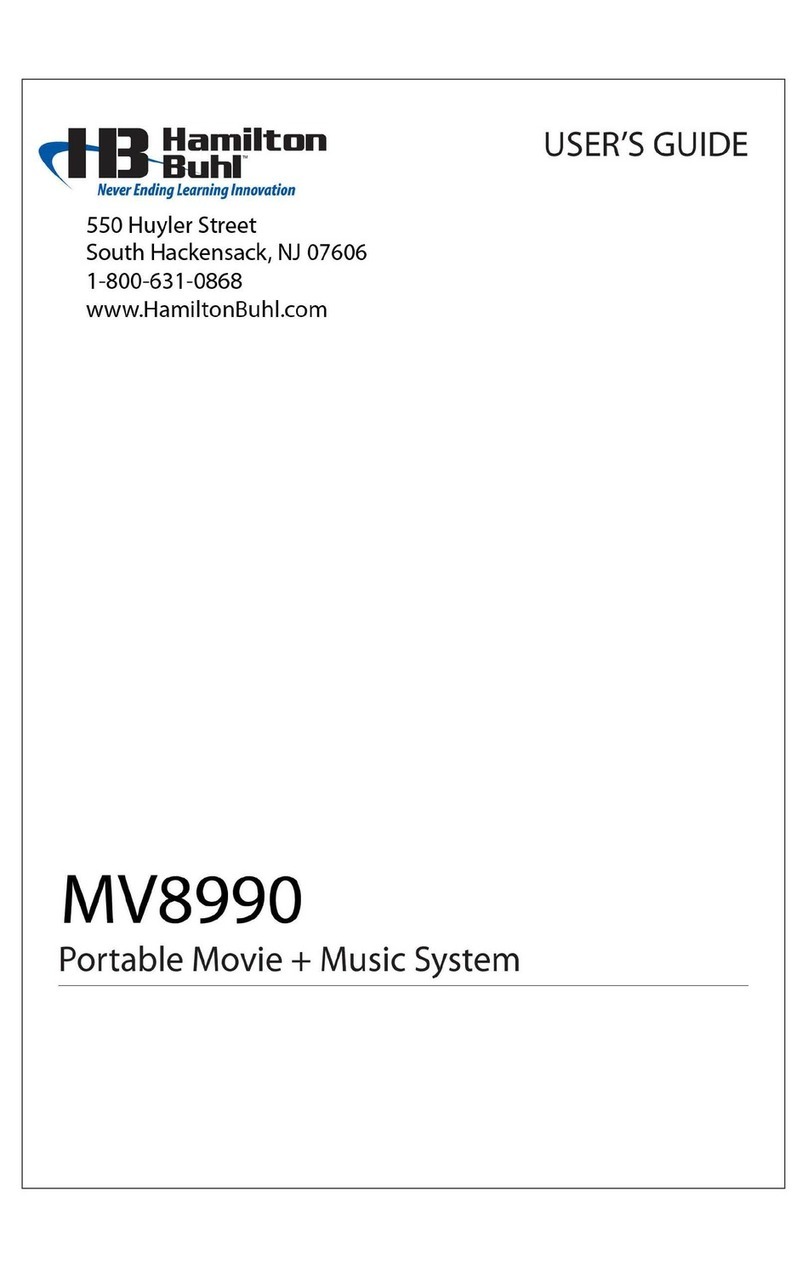
Hamilton/Buhl
Hamilton/Buhl MV-8990 user guide
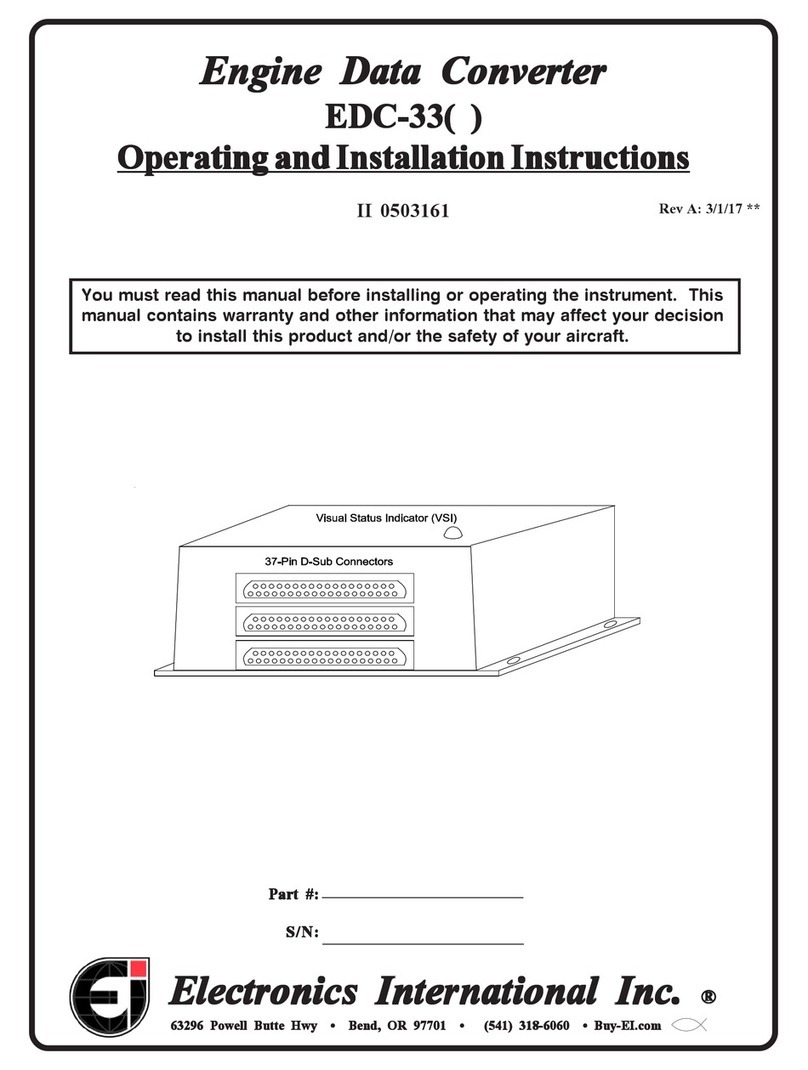
Electronics International Inc
Electronics International Inc EDC-33 Series Operating and installation instructions
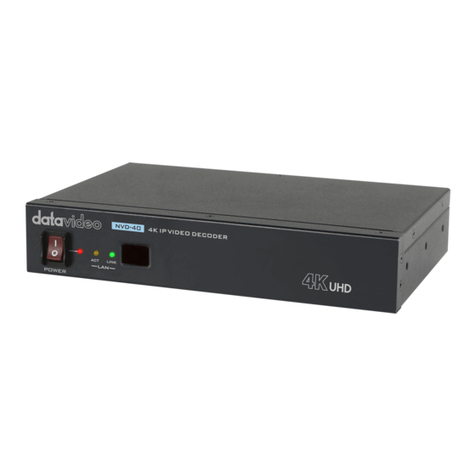
Data Video
Data Video NVD-40 instruction manual
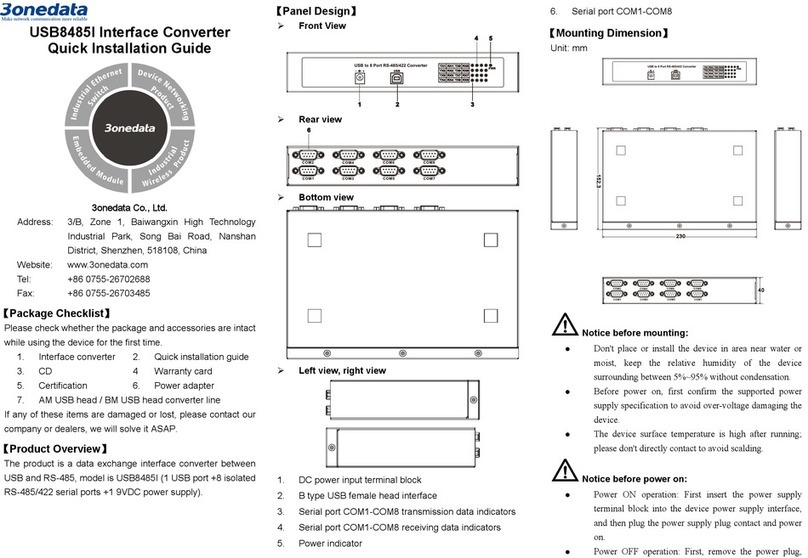
3One data
3One data USB8485I Quick installation guide

